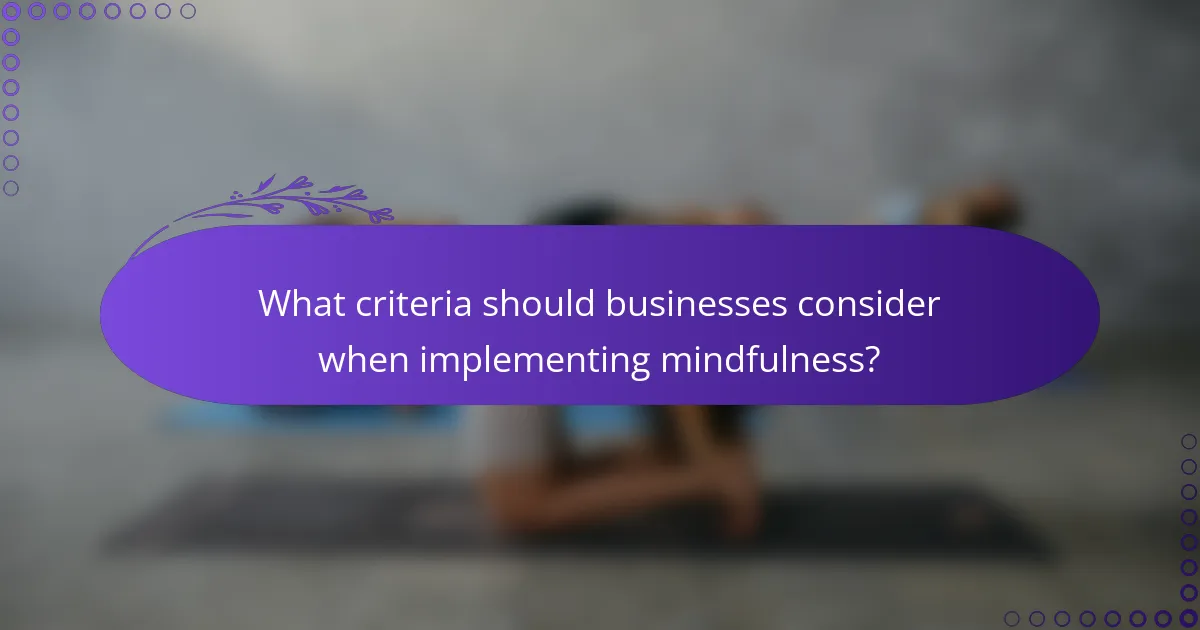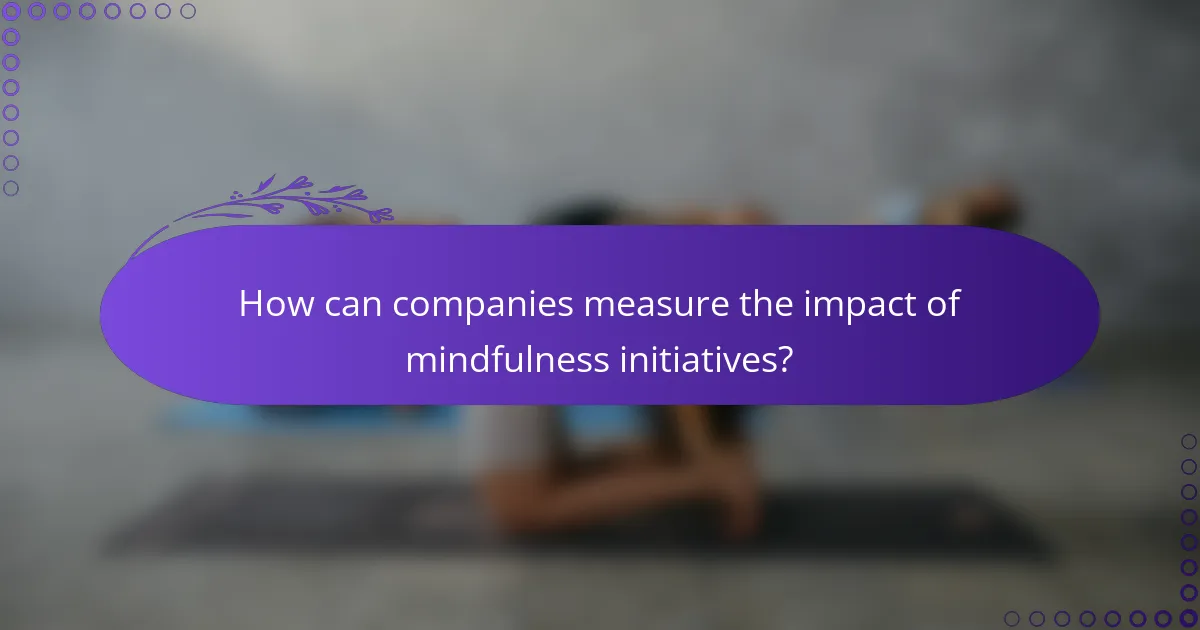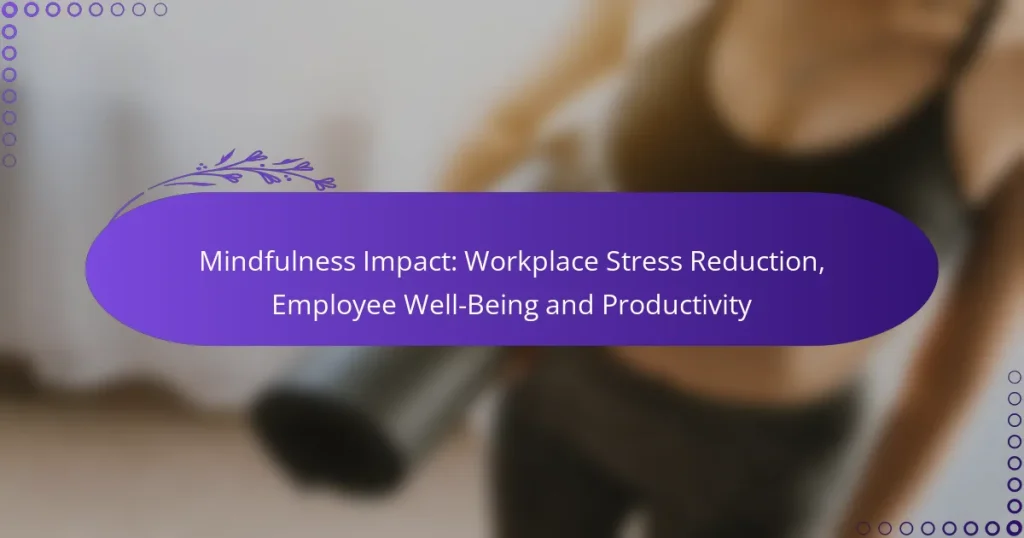Mindfulness has emerged as a powerful tool for reducing workplace stress and enhancing employee well-being. By fostering awareness and acceptance of the present moment, mindfulness practices help individuals manage stress more effectively, leading to improved mental health and job satisfaction. Additionally, these practices promote focus and engagement, ultimately boosting productivity and collaboration within teams.

How does mindfulness reduce workplace stress?
Mindfulness reduces workplace stress by promoting awareness and acceptance of the present moment, which helps employees manage their reactions to stressors. By practicing mindfulness techniques, individuals can cultivate a calmer mindset, leading to decreased anxiety and improved overall well-being.
Lower cortisol levels
Mindfulness practices, such as meditation and deep breathing, have been shown to lower cortisol levels, a hormone associated with stress. Regular engagement in mindfulness can lead to sustained reductions in cortisol, which may help employees feel more relaxed and less overwhelmed during work hours.
For instance, a brief daily mindfulness session of 10-15 minutes can significantly impact cortisol levels over time. Employees can incorporate mindfulness breaks into their schedules to help manage stress effectively.
Enhances emotional regulation
Mindfulness enhances emotional regulation by allowing individuals to observe their thoughts and feelings without immediate reaction. This increased awareness helps employees respond to challenging situations more thoughtfully rather than impulsively.
Practicing mindfulness can lead to better conflict resolution and improved interpersonal relationships at work. Employees who regularly practice mindfulness may find themselves handling workplace stressors with greater composure and empathy.
Improves focus and clarity
Mindfulness improves focus and clarity by training the mind to concentrate on the present moment, reducing distractions. This heightened focus can lead to increased productivity and better decision-making in the workplace.
Employees can enhance their focus by dedicating a few minutes each day to mindfulness exercises, such as mindful breathing or body scans. These practices can help clear mental clutter, enabling individuals to tackle tasks more efficiently and with greater clarity.

What are the benefits of mindfulness for employee well-being?
Mindfulness practices can significantly enhance employee well-being by reducing stress and promoting a positive work environment. These benefits lead to improved mental health, increased job satisfaction, and stronger collaboration among team members.
Increased job satisfaction
Mindfulness can lead to higher job satisfaction by helping employees manage stress and cultivate a positive mindset. When workers practice mindfulness, they often feel more engaged and fulfilled in their roles, which can translate into lower turnover rates.
Employers can encourage mindfulness through workshops, meditation breaks, or quiet spaces for reflection. Simple practices like mindful breathing or gratitude journaling can be integrated into daily routines to foster a more satisfying work experience.
Enhanced mental health
Practicing mindfulness has been shown to reduce symptoms of anxiety and depression among employees. By focusing on the present moment, individuals can develop healthier coping mechanisms for workplace stressors, leading to improved mental health overall.
Organizations should consider offering mindfulness training or resources, such as access to apps or guided sessions. Regular mindfulness practices can help employees build resilience and maintain a balanced emotional state, which is crucial for long-term well-being.
Stronger team dynamics
Mindfulness can enhance team dynamics by promoting empathy and effective communication among colleagues. When team members practice mindfulness, they are more likely to listen actively and respond thoughtfully, which fosters a collaborative atmosphere.
To strengthen team dynamics, companies can implement group mindfulness exercises or team-building activities that incorporate mindfulness principles. This not only improves interpersonal relationships but also encourages a supportive work culture where everyone feels valued.

How does mindfulness improve productivity?
Mindfulness enhances productivity by fostering focus, reducing stress, and promoting a positive work environment. By encouraging employees to be present and engaged, mindfulness practices can lead to better decision-making and increased efficiency.
Boosts creativity
Mindfulness can significantly boost creativity by allowing individuals to think more freely and explore new ideas without the constraints of stress. When employees practice mindfulness, they often experience improved mental clarity, which can lead to innovative solutions and creative problem-solving.
For example, a team that incorporates short mindfulness breaks may find that brainstorming sessions yield more diverse and imaginative ideas. This creative boost can be particularly beneficial in industries that rely heavily on innovation and adaptability.
Reduces absenteeism
Implementing mindfulness practices can lead to a noticeable reduction in absenteeism. By addressing stress and promoting mental well-being, employees are less likely to take sick days or leave due to burnout. Organizations that support mindfulness often see a healthier workforce.
A study might reveal that companies with mindfulness programs experience absenteeism rates that are significantly lower than industry averages, translating to cost savings and improved team dynamics. Encouraging mindfulness can be a proactive approach to employee health.
Improves time management
Mindfulness enhances time management skills by helping employees prioritize tasks and maintain focus on their current responsibilities. When individuals practice mindfulness, they become more aware of their time usage and can identify distractions that hinder productivity.
For instance, a simple technique like the Pomodoro Technique, combined with mindfulness, can help employees stay on task for set intervals, followed by short breaks. This method not only boosts productivity but also encourages a balanced work pace, reducing feelings of overwhelm.

What mindfulness programs are effective in the workplace?
Effective mindfulness programs in the workplace focus on reducing stress, enhancing employee well-being, and boosting productivity. These programs often include structured practices that help employees cultivate awareness and manage their responses to stressors.
Mindfulness-Based Stress Reduction (MBSR)
Mindfulness-Based Stress Reduction (MBSR) is a structured program that typically spans eight weeks, combining mindfulness meditation and yoga. Participants learn to observe their thoughts and feelings without judgment, which can lead to reduced stress and improved emotional regulation.
Organizations implementing MBSR often see a decrease in employee burnout and an increase in job satisfaction. Sessions can be held in-person or online, making it accessible for various workplace settings.
Search Inside Yourself program
The Search Inside Yourself program, developed at Google, integrates mindfulness with emotional intelligence training. This program focuses on self-awareness, empathy, and resilience, aiming to enhance interpersonal skills and workplace relationships.
Typically delivered over several sessions, it encourages participants to practice mindfulness techniques that foster a positive work environment. Companies adopting this program often report improved team dynamics and communication.
Headspace for Work
Headspace for Work offers a digital platform that provides guided meditations and mindfulness exercises tailored for the workplace. This program is designed to fit into busy schedules, allowing employees to engage in short sessions throughout the day.
With features like personalized plans and progress tracking, Headspace for Work can help organizations promote mental well-being and reduce stress levels among employees. Companies using this platform often find it enhances overall productivity and morale.

What criteria should businesses consider when implementing mindfulness?
Businesses should evaluate several key criteria when implementing mindfulness programs, including employee engagement levels, program accessibility, and integration with company culture. These factors can significantly influence the effectiveness and acceptance of mindfulness initiatives within the workplace.
Employee engagement levels
Understanding employee engagement levels is crucial for tailoring mindfulness programs to meet the needs of the workforce. Engaged employees are more likely to participate in mindfulness activities, which can lead to improved stress reduction and productivity. Conducting surveys or focus groups can help gauge interest and identify specific areas where mindfulness could be beneficial.
To enhance engagement, consider offering a variety of mindfulness practices, such as meditation, yoga, or breathing exercises, to cater to diverse preferences. Regularly assessing participation rates and feedback can help refine these offerings and maintain high levels of interest.
Program accessibility
Accessibility is a vital aspect of any mindfulness program. Ensure that resources are available to all employees, regardless of their work schedules or locations. This might include offering virtual sessions, recorded materials, or flexible timing to accommodate different shifts.
Additionally, consider providing materials in multiple languages or formats to reach a broader audience. Making mindfulness resources easily accessible can lead to higher participation rates and a more inclusive workplace environment.
Integration with company culture
For mindfulness programs to be effective, they must align with the existing company culture. This means that leadership should actively support and participate in mindfulness initiatives, demonstrating their value to the organization. When mindfulness is seen as a priority from the top down, employees are more likely to embrace it.
Incorporating mindfulness into daily routines, such as starting meetings with a brief meditation or encouraging breaks for mindfulness practices, can help normalize these activities. This integration fosters a culture of well-being and can lead to lasting changes in employee attitudes and behaviors.

How can companies measure the impact of mindfulness initiatives?
Companies can measure the impact of mindfulness initiatives through various methods, including employee surveys, productivity metrics, and overall workplace culture assessments. These approaches provide insights into how mindfulness practices affect employee well-being and organizational performance.
Employee surveys and feedback
Employee surveys are a direct way to gauge the effectiveness of mindfulness initiatives. Companies can use anonymous questionnaires to assess changes in stress levels, job satisfaction, and overall mental health before and after implementing mindfulness programs.
To ensure meaningful feedback, surveys should include specific questions about mindfulness practices, such as frequency of participation and perceived benefits. Regularly scheduled surveys, perhaps quarterly, can help track progress over time and identify areas for improvement.
Productivity metrics
Productivity metrics provide quantitative data on the effectiveness of mindfulness initiatives. Companies can analyze key performance indicators (KPIs) such as output quality, employee absenteeism, and time management to see if mindfulness practices correlate with improved performance.
For instance, organizations might observe a reduction in absenteeism rates or an increase in project completion rates following the introduction of mindfulness training. Tracking these metrics over time can help establish a clearer link between mindfulness and productivity enhancements.


